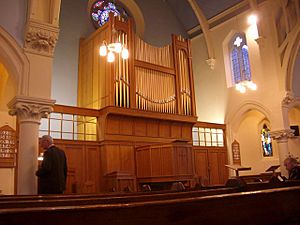St Andrew's with Castle Gate United Reformed Church facts for kids
Quick facts for kids St Andrew's with Castlegate United Reformed Church |
|
|---|---|

St Andrew's with Castlegate United Reformed Church
|
|
| 52°57′24.390″N 1°9′13.565″W / 52.95677500°N 1.15376806°W | |
| Denomination | United Reformed |
| Website | standrewswithcastlegate.org.uk |
| Architecture | |
| Heritage designation | Grade II listed |
| Architect(s) | Robert Evans JP |
| Style | Early decorated Gothic |
| Groundbreaking | 21 September 1869 |
| Completed | 29 September 1870 |
| Construction cost | £4,000 (equivalent to £274,280 in 2021). |
| Specifications | |
| Capacity | 600 people |
St Andrew's with Castle Gate United Reformed Church is a church located in Nottingham, England. It is a place where people gather for worship and community activities.
Contents
How the Church Was Formed
St Andrew's with Castle Gate United Reformed Church was created in 1975. This happened when two older churches, St Andrew's URC and Castle Gate URC, decided to join together. This union followed the creation of the United Reformed Church in the UK in 1972. Before 1975, St Andrew's was a leading Presbyterian Church, founded in 1870. Castle Gate was a main Congregational Church, which started around 1665.
The Church Buildings
After the two churches joined, the members decided to keep using the building that belonged to the former St Andrew's Church. This building is on Goldsmith Street in Nottingham. It is still used today for church services and many other activities. The old Castle Gate building was taken over by the Congregational Federation. This group includes Congregational Churches that chose to remain independent. The old Castle Gate building is now known as The Castle Gate Centre.
A Look at the Church's Past
The church has a long and important history of Christian work in Nottingham. The story of Castle Gate Congregational Church goes back to the mid-1600s, during the time of the English Civil War. A group of people who disagreed with the main church, called Independents (or Congregationalists), first set up a church in Castle Gate in 1689. The building they use today opened in 1864. The St Andrew's Presbyterian Church was officially formed in 1866, and its current building opened in 1870.
Both churches helped start new churches in the area during the 1800s and 1900s. Castle Gate helped create churches like The Boulevard (1823), Albion (1856), and Addison Street (1867). St Andrew's started the Hyson Green Mission in 1885, which had a new church building opened in 1901. In 1896, St Columba's was opened, and it later rejoined St Andrew's in 1946. In 1971, the St Ann's Well Road Congregational Church joined with Castle Gate Congregational Church. This happened just before most Congregational Churches in England and Wales joined with the English Presbyterian Church to form the United Reformed Church.
In October 2022, the church members decided to be more welcoming to all people. They shared statements online showing their commitment to including everyone in their community.
Church Records
The old records and important papers of St Andrew's with Castle Gate URC are kept at The Department of Manuscripts and Special Collections at The University of Nottingham. These records are available for people who need to research the church's history.
The Church Organ
The organ in the church was rebuilt in 1936 by J.W. Walker. It was updated again in 1982. You can find more details about this organ on the National Pipe Organ Register.
See also
- Listed buildings in Nottingham (Hyson Green and Arboretum ward)


